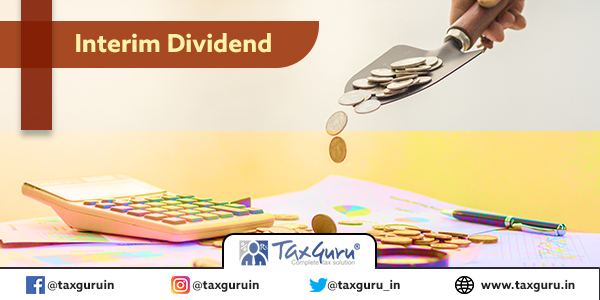As per Section- 2(35) ‘dividend includes interim dividend’ signifies that the provisions of Companies Act 2013, applicable to the final dividend to the extent possible, shall also applicable on interim dividend.
As the word “interim” means “relating to less than a full year’s business activity” so the dividend declared in the middle or before the end of the financial activity is called an Interim Dividend.
Interim Dividend is the dividend declared and distributed by a company to its shareholders prior to the determination of final profit position for the financial year. Before interim dividends are paid, the company’s financial statements will also be audited.
Through this Articles we will be discussing some major points that needs to be keep in mind while declaring the Interim Dividend under Section 123 (3) of the Companies Act, 2013 and also the Tax Treatment of Dividend Income after Finance Act, 2020 came into force:-
Section 123 (3): Declaration of Interim Dividend-
1. Articles must authorize for payment of dividend, the board will not be able to recommend dividend for the approval members. Similarly, unless there is a provision in the articles authorizing the Board to approve for payment of interim dividend, the Board cannot take any action in respect of payment of interim dividend.
2. The Board of Directors of a company may declare interim dividend during any financial year or at any time during the period from closure of financial year till holding of the annual general meeting out of the surplus in the profit and loss account or out of profits of the financial year for which such interim dividend is sought to be declared or out of profits generated in the financial year till the quarter preceding the date of declaration of the interim dividend. (Provided that in case the company has incurred loss during the current financial year up to the end of the quarter immediately preceding the date of declaration of interim dividend, such interim dividend shall not be declared at a rate higher than the average dividends declared by the company during the immediately preceding three financial years)
3. Directors have to prepare a proforma for profit and loss account and balance sheet of the company upto the latest possible date of the financial year in respect of which interim dividend is proposed to be declared and provision must be made for all the working expenses and depreciation for the whole year.
4. The amount of the dividend, including interim dividend, shall be deposited in a scheduled bank in a separate account within five days from the date of declaration of such dividend. The amount so transferred shall not be utilized for any other purpose. The same shall be paid within 30 days of declaration by the Board.
5. No company can pay dividend in any year without charging depreciation in the profit and loss account for the current year and that there is no balance of un provided depreciation of any earlier year or years.
6. Prepare a statement of dividend in respect of each shareholder containing the following details:
- Name and address of the shareholder with ledger Folio No.
- of shares held.
- Dividend payable
7. Approval of members at the general meeting for Interim dividend and also in the director’s report for the approval of members at the forthcoming AGM.
Tax Treatment of Dividend Income:
1. Since Dividend Distribution Tax is abolished on companies as per Finance Act, 2020, dividends distributed by companies on or after 1 April 2020 are taxable income of the investor now.
2. Section 115BBDA of the Income Tax Act, which provides for taxability of dividend in excess of Rs. 10 lakh has no relevance now, as the entire amount of dividend shall be taxable in the hands of the shareholders.
3. As per the new provisions, an Indian company is required to deduct the applicable tax at source under Sections 194 & 195 of the Income Act, 1961.
4. Section 194 covers the payment of Dividend on Equity Shares to a resident shareholder exceeding INR 5000 in a financial year.
5. In case of resident shareholders, TDS at the rate of 10% shall be deducted by the payer and in case the payee does not provide the PAN, TDS shall be deducted at the rate of 20%.
6. In case of non-resident shareholders, TDS at the rate of 20% shall be deducted by the payer.
After the abolishment of DDT, entrepreneurs may lean towards the company format instead of setting up of a firm or LLP but only if they can handle the burden of other compliances which a company needs to comply with.






